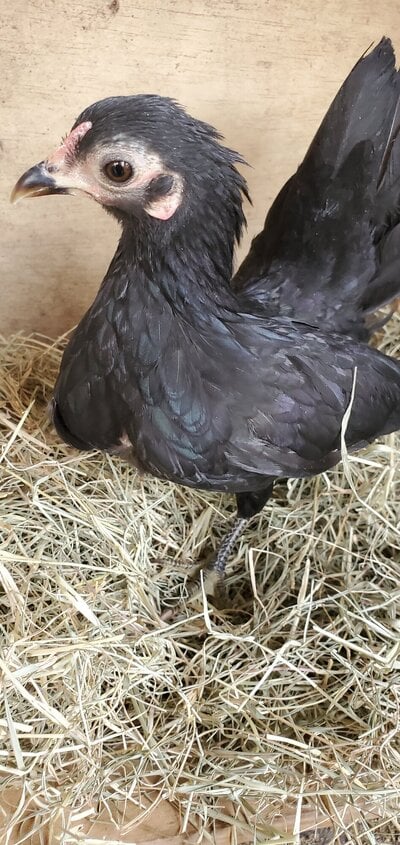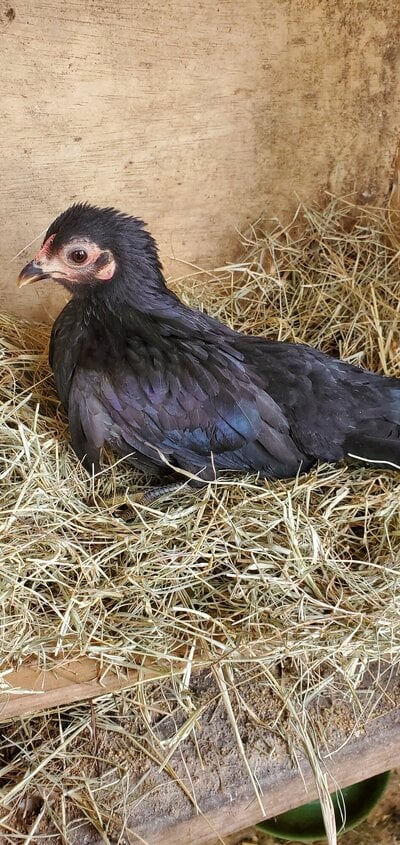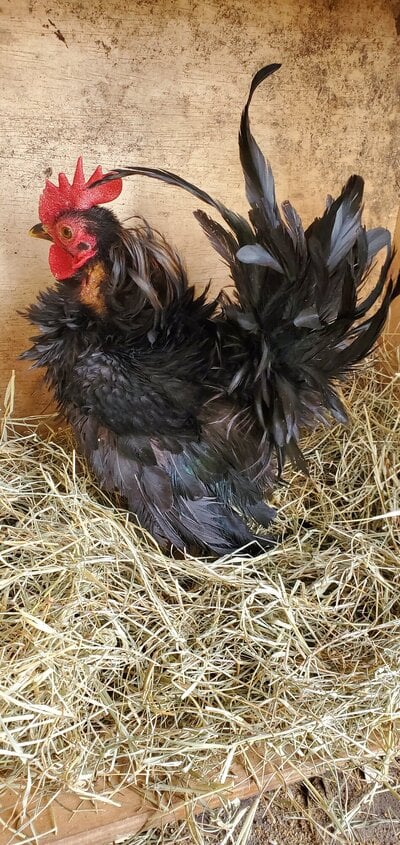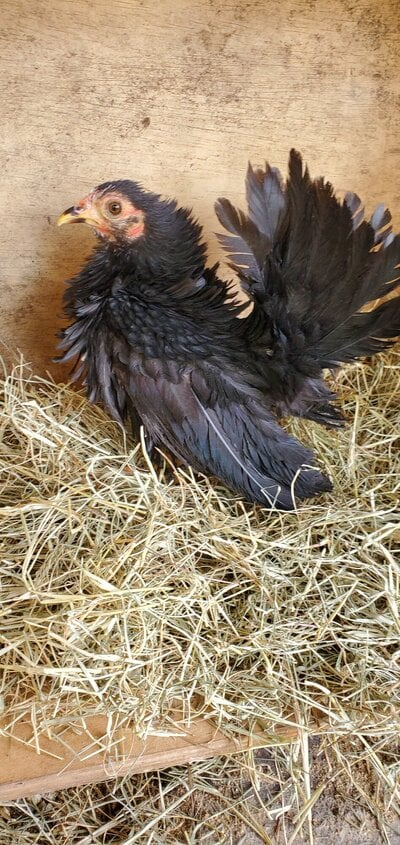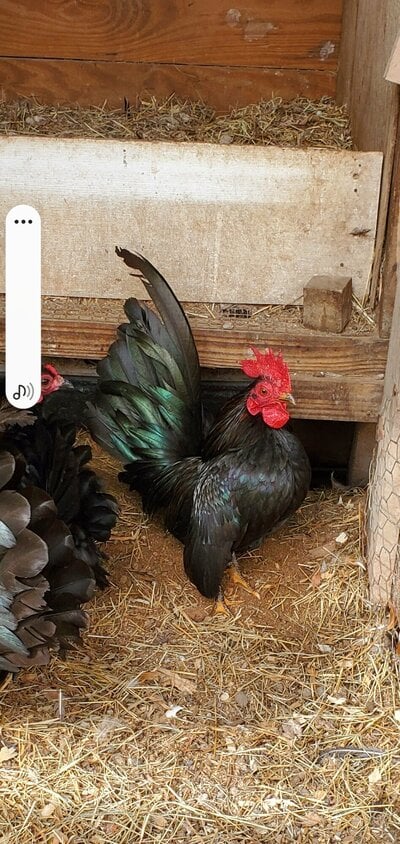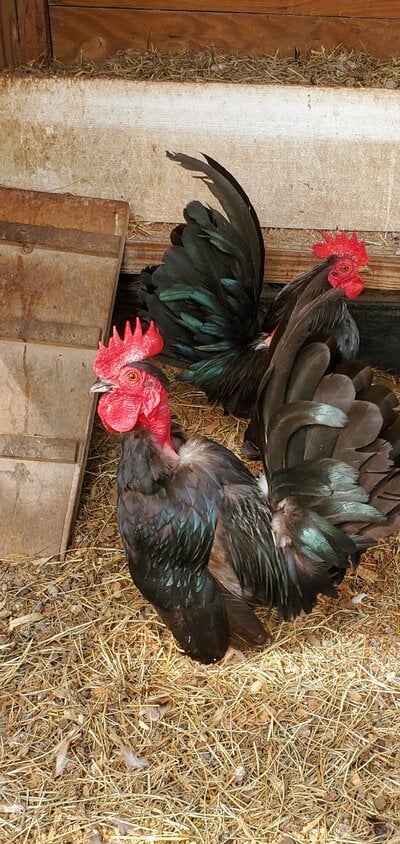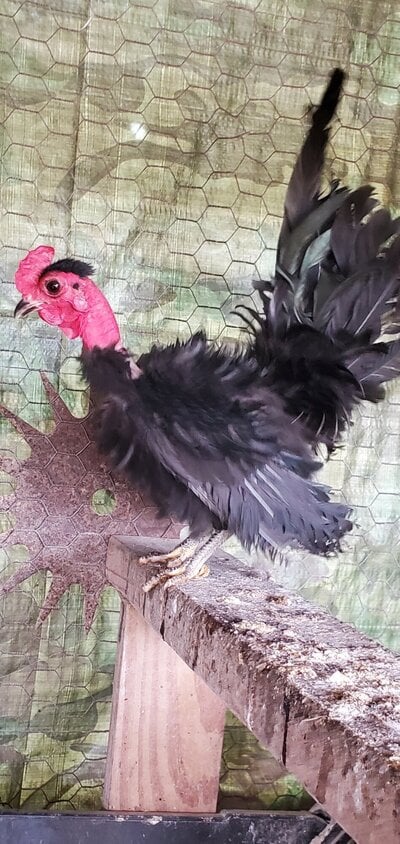ChickensInMA
Chirping
Kikirikis! They've honestly become my favourite type of chicken. They're super docile and come in every colour and shape under the sun. Kikiriki is the sound a rooster makes in Spanish, but it can also be used as a nickname for bantams in Spanish, especially Latin American ones. Does anyone else here raise these? I've seen a few posts on here about them, but nothing in detail. The majority of the people here who know about them seem to think that they are just Caribbean seramas, but that does not do them justice. These are the descendants of cockfighting birds, bred down to be small and exaggerate certain features. They are really small bantams, like seramas, but with much more variety. To me, I think seramas seem boring in comparison. I have quite a few of them, and they make fantastic pets. They come in all sorts of colours and styles, but they aren't a recognised breed. They have a huge following in Puerto Rico, Cuba, the Dominican Republic, Florida and other places in the Caribbean.
I've been told they can't handle temperatures below 50°F (10°C), but I've had them outside in Massachusetts in temperatures as low as 20°F (-7°C) so far. I have a small heater in their well-insulated coop which only goes on when temperatures are beneath 28°F (-2°C), and it raises the temperature in their coop about ten degrees warmer than the outside temperature. I don't want it warm in their, just enough to keep them alive. Their yard is completely covered in plastic this winter as a windbreak. It's clear they can't tolerate it as well as my other birds, but they've been surviving so far.
I wanted to share some of mine and see some that other people might have. I was thinking about writing an article on them based off of what I know, if enough people are interested in learning about them. If you don't speak Spanish, however, it would be difficult to buy them. All of the breeders I've met are awesome, amazing people, but you really need to know Spanish to communicate.
Anyway, here are some of mine! There is much more variety out there, but I'll start off with what I have, and people are interested, I'll show you some of the really nice, competition-quality ones that others have.




This one is Tiny. She is my favourite one, as she was my introduction to kiris. I bought her at a flea market in West Palm Beach. She was too little to live with my chickens when I first got her, so she used to live with my quail. As you can see, kiris are quite good flyers. She flew up to the top of the roof of the shed as if she were a normal bird, about twelve feet (3,5m). She's extremely friendly, and very hand-tame. We have a childcare at our home, so she makes a fantastic pet for the children.



This is Peloncilla (little baldy in Spanish). She is a piroca (naked neck) and a bola (rumpless, literally means 'ball' ). She's my 'special' chicken. The first picture is her in the box when I was taking her home, and the second is her in her new coop. For those familiar with it, the box is a Dunkin' Donuts Munchkin box, so this'll give you a reference for size. She is about eighteen months in the first picture.
). She's my 'special' chicken. The first picture is her in the box when I was taking her home, and the second is her in her new coop. For those familiar with it, the box is a Dunkin' Donuts Munchkin box, so this'll give you a reference for size. She is about eighteen months in the first picture.

This one is Negrita (little blacky). She is a moñahueso (This term, although ungrammatical in Spanish, means a crested kikiriki, or one with a vaulted skull, like a Polish chicken. Moña means 'bun' or 'ribbon', and hueso means 'bone'. Moñahueso can be translated as 'bone-bun'.) and also a pata corta (a chicken with the short-leg gene, like that found in Japanese Bantams. Pata usually means 'paw', but a better translation is 'animal foot'. Birds don't have 'paws' in English, but both dogs and chickens have patas in Spanish, for example.) Moñahuesos and patas cortas are usually the most expensive kind of kiri to buy, due to their low hatch rates. Small-sized chicks with vaulted skulls and the potencially-lethal short-leg gene can lead to hatch rates of about 60% sometimes.


Here are the two of them after I snuck them on a commerical flight from Florida! Spirit flights allow birds, but only 'small, household birds' and not 'farmyard poultry'. I only showed the gate agent Negrita, and told her it was a black dove. It worked, and I even managed to do it a second time since then! I've brought a total of nine kikirikis home to Massachusetts this way.




These two are Calabaza (pumpkin in Spanish) and Poppy. They are also both moñahuesos and patas cortas.


Here is one of my hens, Minky, with her chick, Bonko. The are with Calabaza and Poppy in the second picture. She is a bola, piroca and a moñahueso. The same goes for her blackish chick. The whitish chick in the box was just a bolo, but unfortunately, it did not survive long. The four of them lived in the bottom of my quail hutch as they acclimatised to the New England weather and got to know the other chickens. They now live with the rest.

Here are some of my kiris living with the other birds in my yard. If anyone is interested in learning more, please ask! This does not cover all of the types, and all of these are mediocre-to-pet quality birds. They get a lot nicer than this. There are a lot of terms to describe the different types of these birds, and although I speak Spanish, I don't know what all of them mean, or what they mean in these situations. I can go more into detail later if you want.
I've been told they can't handle temperatures below 50°F (10°C), but I've had them outside in Massachusetts in temperatures as low as 20°F (-7°C) so far. I have a small heater in their well-insulated coop which only goes on when temperatures are beneath 28°F (-2°C), and it raises the temperature in their coop about ten degrees warmer than the outside temperature. I don't want it warm in their, just enough to keep them alive. Their yard is completely covered in plastic this winter as a windbreak. It's clear they can't tolerate it as well as my other birds, but they've been surviving so far.
I wanted to share some of mine and see some that other people might have. I was thinking about writing an article on them based off of what I know, if enough people are interested in learning about them. If you don't speak Spanish, however, it would be difficult to buy them. All of the breeders I've met are awesome, amazing people, but you really need to know Spanish to communicate.
Anyway, here are some of mine! There is much more variety out there, but I'll start off with what I have, and people are interested, I'll show you some of the really nice, competition-quality ones that others have.
This one is Tiny. She is my favourite one, as she was my introduction to kiris. I bought her at a flea market in West Palm Beach. She was too little to live with my chickens when I first got her, so she used to live with my quail. As you can see, kiris are quite good flyers. She flew up to the top of the roof of the shed as if she were a normal bird, about twelve feet (3,5m). She's extremely friendly, and very hand-tame. We have a childcare at our home, so she makes a fantastic pet for the children.
This is Peloncilla (little baldy in Spanish). She is a piroca (naked neck) and a bola (rumpless, literally means 'ball'
 ). She's my 'special' chicken. The first picture is her in the box when I was taking her home, and the second is her in her new coop. For those familiar with it, the box is a Dunkin' Donuts Munchkin box, so this'll give you a reference for size. She is about eighteen months in the first picture.
). She's my 'special' chicken. The first picture is her in the box when I was taking her home, and the second is her in her new coop. For those familiar with it, the box is a Dunkin' Donuts Munchkin box, so this'll give you a reference for size. She is about eighteen months in the first picture.This one is Negrita (little blacky). She is a moñahueso (This term, although ungrammatical in Spanish, means a crested kikiriki, or one with a vaulted skull, like a Polish chicken. Moña means 'bun' or 'ribbon', and hueso means 'bone'. Moñahueso can be translated as 'bone-bun'.) and also a pata corta (a chicken with the short-leg gene, like that found in Japanese Bantams. Pata usually means 'paw', but a better translation is 'animal foot'. Birds don't have 'paws' in English, but both dogs and chickens have patas in Spanish, for example.) Moñahuesos and patas cortas are usually the most expensive kind of kiri to buy, due to their low hatch rates. Small-sized chicks with vaulted skulls and the potencially-lethal short-leg gene can lead to hatch rates of about 60% sometimes.
Here are the two of them after I snuck them on a commerical flight from Florida! Spirit flights allow birds, but only 'small, household birds' and not 'farmyard poultry'. I only showed the gate agent Negrita, and told her it was a black dove. It worked, and I even managed to do it a second time since then! I've brought a total of nine kikirikis home to Massachusetts this way.

These two are Calabaza (pumpkin in Spanish) and Poppy. They are also both moñahuesos and patas cortas.
Here is one of my hens, Minky, with her chick, Bonko. The are with Calabaza and Poppy in the second picture. She is a bola, piroca and a moñahueso. The same goes for her blackish chick. The whitish chick in the box was just a bolo, but unfortunately, it did not survive long. The four of them lived in the bottom of my quail hutch as they acclimatised to the New England weather and got to know the other chickens. They now live with the rest.
Here are some of my kiris living with the other birds in my yard. If anyone is interested in learning more, please ask! This does not cover all of the types, and all of these are mediocre-to-pet quality birds. They get a lot nicer than this. There are a lot of terms to describe the different types of these birds, and although I speak Spanish, I don't know what all of them mean, or what they mean in these situations. I can go more into detail later if you want.

